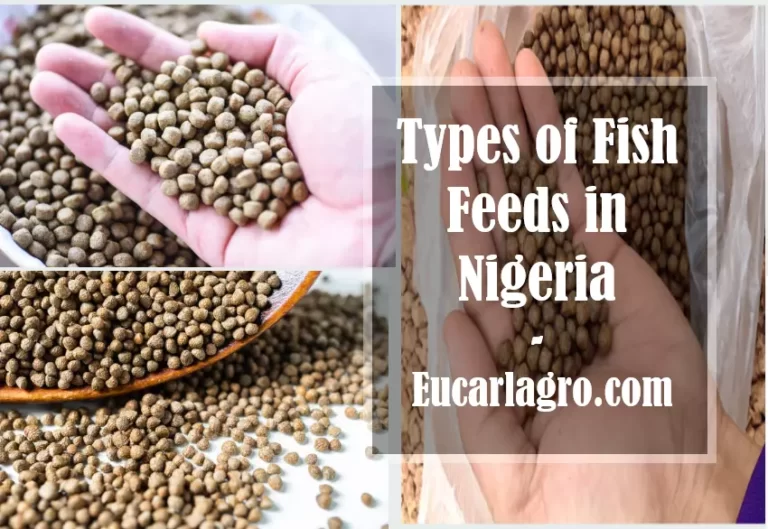6 Types of Ponds For Fish Farming
What are the different types of Ponds For Fish Farming? So you want to start a fish farming business in Nigeria and wondering about the types of ponds, requirements, and how to construct a fish pond? Read on.
Fish farming is the science of rearing fish for personal consumption and business. In Nigeria, Catfish is the most farmed and sold fish. This is a result of its pleasant taste and big size. Fishes leave in water, and to be able to farm fish outside oceans, or their natural habitat we need a body similar to their natural habitat.

What is a Fish Pond?
A Fish pond is a man-made or artificial habitat for fish, established, controlled, and maintained by the farmer for fish production. In the 14th to early 19th-century fish ponds were the pride of every monastery and convent in Europe.
In present days, a fish farm is more of a business than a pride factor. Now, Fish ponds are constructed according to the plan of farmers and to meet their goals. And they are several types of ponds for fish farming.
Types of Ponds for Fish Farming
There are many types of ponds for fish farming, here we will be only listing 6 types of Ponds for fish farming, with their advantages, disadvantages, and factors to be considered before venturing into any of them.
Earthen Ponds
The earthen pond is one of the types of ponds for fish farming, that is immediate to the natural habitat of a fish. That is, it is near-natural. Earthen ponds are constructed at least 1.5m deep in non-concrete(soil), in a sloppy or waterlogged area depending on the farmer’s design. Earthen ponds are made by experienced professionals in the work constructing this type of fish pond.
Factors to be considered before constructing an earthen fish pond.
Location of the Land: Earthen ponds get their water from natural sources, not artificial sources. Therefore in locating your fish pond, get a land close to a good sustainable water source like water coming from streams, and river diversions.
Soil type: Earthen pond is best when constructed in Clay soil, due to its high water retention ability and its ability to mold. This is very important and should not be neglected.
Soil Permeability: another pertinent factor that is worth your concern in constructing an earthen pond is Soil Permeability. Soil Permeability is a property of soil to transmit air or water. In fish farming, we use soil with very low permeability to keep the pond from drying up easily. This is the reason why clay is the best soil type for an earthen fish pond.
Soil Texture: Soil texture is all about the feel of the soil. Land used to construct earthen ponds should be fine-grained with more than 50% being silt and clay.
Advantages of Earthen Pond
1. It has a construction resembling a fish’s natural habitat which yields good fish.
Due to the nature of an earthen pond, fishes can feed on natural food like warm, plankton, and more organic matter.
2. Aids Faster growth
3. Low maintenance cost
4. Better water management
Disadvantages of Earthen Pond
1. It is prone to flood
2. Earthen ponds require large space for their construction.
3. It is prone to disease outbreak
4. Difficulty in sorting
Also read: How to Design and Construct a Fish Pond
Concrete Ponds
A concrete Pond is another example type of pond for fish farming. It is predominantly used in rearing catfish and it is also beneficial to the farmer because it doesn’t require vast land and can even be built in a residential compound.
The construction of a Concrete pond needs high and more experienced professionalism(due to leakage) than any other type of fish pond. All you need to start construction is sand, blocks, cement bags, and a professional concrete fish pond constructor.
Factors to be considered before constructing an earthen fish pond
Location: due to the nature of the concrete pond unlike the earthen pond, that needs to be put into a lot of consideration(especially in location sitting), but doesn’t need any head racking in finding a location. A person can build a concrete pond anywhere even in the backyard.
Cost: concrete ponds are money demanding to construct and maintain. Before jumping into a concrete pond project check your financial strength because concrete ponds are the most expensive among other types of fish ponds.
Drainage system: concrete ponds unlike earthen ponds are not stagnant ponds, their water would need changing. The drainage system is a very important factor that should be thought of even before the concrete pond project.
Advantages of Concrete Pond
1. It can be constructed anywhere on land even in our houses.
2. Fish diseases are easily detected in Concrete Ponds.
3. It helps in nurturing young fishes like fingerlings.
4. Concrete Ponds are not prone to floods, unlike earthen ponds.
If managed well, it lasts longer.
Disadvantages of Concrete Pond
1. High cost of construction
2. High cost of maintenance
3. Water usage is much compared to other types of ponds for fish farming.
4. Drainage issues can cause pollution.
Plastic or Rubber Pond
The third type of Pond for fish farms used is the Plastic Pond. Plastic ponds are made from plastic (rubber). Most users of the type of fish pond construct it by cutting old tanks. They are easy to set up and use and that’s why it is the beginner’s best pond. It doesn’t need professional help to use, a starter can control it.
Factors to be considered before setting up a Plastic (rubber) pond
Space: Unlike other types of ponds for fish farming, Plastic ponds don’t require vast land, it just needs a small space. This factor should be put into consideration before buying the land for the fish farm.
Cost: Before you proceed with a plastic pond project, weigh your pocket wisely. Plastic ponds are not too expensive unlike other types of Ponds for fish farming, but they are not free either. You will need to buy Plastic tanks (cut into two), pipes for the inlet and outlet of water, and have a good and steady water supply. Count the cost
Quantity: For a beginner who intends to start small or medium, you have to know the quantity of fish you intend on farming before proceeding to purchase plastic ponds, or else it might be an unnecessary expense.
Advantages of Plastic fish pond
1. It is easy to set up
2. It doesn’t need much space, a small land will do
3. Fingerings and juvenile fishes grow very well in plastic ponds.
4. It is not prone to disease, unlike the Earthen pond.
5. Absence of flooding cases.
6. The ponds are easy to maintain.
7. They are moveable.
8. Plastic pond doesn’t cause pollution, unlike concrete ponds.
9. Sorting fish is easy.
10. It can be used to rear fish indoors unlike other types of ponds for fish farming
Disadvantages of Plastic fish pond
1. The plastic can expire due to the heat of the Sun and the time of production
2. Fishes are not able to feed on natural foods like fishes in earthen ponds do.
3. It is water demanding and time demanding
Tarpaulin Ponds
Tarpaulin is a heavy-duty waterproof cloth. Tarpaulin Ponds are types of ponds constructed with tarpaulin. Tarpaulin ponds are cost-effective and are not complex to set up. Although there are professionals who construct tarpaulin ponds, someone with knowledge of its construction can make it with little or no help using wood or pipes, and the tarpaulin. Tarpaulin ponds come in different sizes and shape depending on you.
Factors to be considered before constructing a Tarpaulin fish pond
Space and Safety: tarpaulin ponds are not space consuming, they can be set up on a small piece of land. Regardless, when setting up a tarpaulin fish pond, check and site it in a place free from sharp objects to avoid tearing the Tarpaulin.
Cost: Tarpaulin is good for small or medium-scale fish farming. If you want to farm large-scale catfish, it’s not advisable to use a tarpaulin pond instead use concrete or earthen because setting up many tarpaulin ponds will cost you more.
Quality: Before setting up a tarpaulin farm, the farmer should examine the quality of the tarpaulin material to avoid cases of tearing weeks after set up. Good quality tarpaulin will save money because the farmer will not be spending on patching and replacement.
Advantages of Tarpaulin Fish Pond
1. It is easy to set up
2. It is moveable.
3. It is cheaper than some other types of ponds like concrete ponds.
4. It is space-conserving unlike other types of ponds for fish farming.
Disadvantages of Tarpaulin Fish Pond
1. Cost more when used in large-scale catfish farming
2. Quality of the tarpaulin depreciation over the years due to the heat of the sun.
3. They are liable to be torn if not maintained very carefully.
4. Tarpaulin fish ponds can easily be pulled apart and stolen.
5. They can get damaged when there is serious rain/flood or wind.
Fiberglass tank
Fiberglass tanks are transparent tanks mostly operated indoors unlike most of the types of ponds used for fish farming before discharging them into the open water. Fiberglass is rare to see in this part of the world. Setting up a fiberglass tank is easy just like Tarpaulin and Plastic Ponds. Its main benefit is that due to the transparent nature of the tanks, monitoring fish activities and growth is very easy.
Advantages of Fiberglass tank
1. It is simple to set up
2. Due to their transparent nature, fiberglass tanks are the best for examining fish activities and progress.
3. They are also beneficial because they are moveable
Disadvantages of Fiberglass tank
1. Due to its size, it cannot be used for large-scale farming.
2. High cost of purchase.
3. It requires the assistance of professionals to install a fiberglass tank (the payment for installation is costly )
Cage Ponds
Cage Pond is one type of fish pond constructed in the center of freshwater because of the large quantity of water, utilizing cage tanks and pegs for firmness.
They are found in the Lagos islands and Niger Delta regions which are surrounded by large water bodies.
They feed on natural foods because they are confined to a cage in their natural habitat.
Advantages of Cage Ponds
1. They support faster growth and better yield
2. Fishes reared in a cage pond never suffer from water shortage.
3. They do not suffer pollution because the water is always moving (fresh)
Disadvantages of Cage Ponds
1. They are prone to flooding
2. Farmers who use them have some issues sorting.
3. They suffer disease outbreaks easily and are difficult to treat
4. They suffer from poaching.
5. Require tight security to avoid poaching
Conclusion
Fish farming is more lucrative when catfish are being reared. There 6 main types of ponds for fish farming, ranging from the common ones like Earthen, Concrete, Plastic, and Tarpaulin ponds to even the rare types like Fiberglass, and Cage ponds. Earthen and Cage ponds are near-natural ponds.
Concrete ponds last longer than other types of ponds for fish farming with the only a few issues like the high cost of production, high water demand, pollution, and inability to rear fish largely in it. Your choice on which of the types of ponds for fish farming now depends on your land size, your financial strength, and the quality of fish you want to rear.
Now you have this knowledge of the types of ponds for fish farming, for more posts follow Eucarlagro.com






